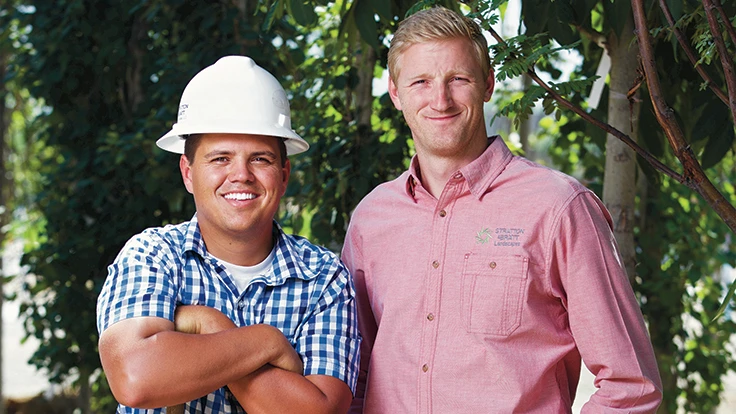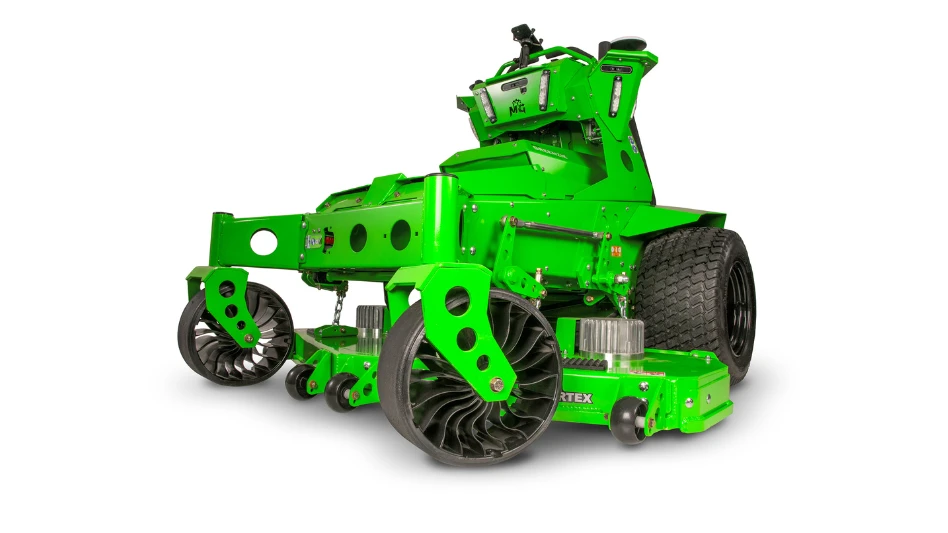
 Cousins Zack and Rob Stratton didn’t get their start in the industry mowing yards around the neighborhood. They had to handle something a bit larger – Zack’s father’s golf course where the duo performed maintenance on the grounds. By the time Zack and Rob got to college, they veered off from tee boxes and sand traps, opting instead for front yards and patios with a landscaping company of their own.
Cousins Zack and Rob Stratton didn’t get their start in the industry mowing yards around the neighborhood. They had to handle something a bit larger – Zack’s father’s golf course where the duo performed maintenance on the grounds. By the time Zack and Rob got to college, they veered off from tee boxes and sand traps, opting instead for front yards and patios with a landscaping company of their own.
The duo started Cascade Landscapes in 2010 when Zack was still in school studying business and landscape management at Brigham Young University. “We did enough projects to keep us going, to pay tuition, and to take out the girls on the weekends. We were more focused on getting our degrees than running the business,” Stratton, 28, says.
Cascade added a couple of crews for small residential installations like flowerbed makeovers, generating about $100,000 in revenue while the Strattons were still in college, but the company stayed small. After graduation, they focused on growing the business.
“I looked at the market and decided that I needed to make friends with the big boys, the guys who’d been doing it for a long time,” Stratton says.
So the Strattons connected with one of those longtimers – Bratt, Inc., a commercial landscape company that’s been operating in nearby Pleasant Grove, Utah since 1967.
“They were almost like mentors to us, and they helped us out in different ways with our pricing structure, company structure and all of that,” Stratton says.
When Bratt’s owners, brothers Jon and Perry, were ready to transition out of the business in their 60s, it was a perfect fit for their young protégés to take over. The Strattons purchased Bratt in July of 2013, forming Stratton & Bratt Landscapes, and leveraging the best of both companies to build a growth-driven business.
Two become one.
Bratt’s owners had built strong brand recognition on decades of experience doing major projects in the area to spec and on budget – leaving big shoes for the Strattons to fill. Now, CEO Zack is one of the youngest people at the company. When he took over, he had to earn the respect of his tenured team. He grew his hair out and leaned toward business casual outfits to look older.
“It was difficult at first,” he says. “The biggest thing, when you’re young, is that you cannot come in arrogant. You need to go in with the attitude that you want to learn and work together. I even had to dress a little bit differently to come off as more of a working professional than some punk kid.”
The acquisition happened mid-season, so the Strattons didn’t have time to make any major changes immediately. That gave them time to learn from Bratt’s best practices and gradually make adjustments – in Stratton’s words, “building the airplane as you fly.”
“We had to evaluate what our strengths were, where we were after the merger and where we wanted to get to,” Stratton says. “It was taking the good they have and the good we have, and trying to mesh the two to make something even better.”
 The goal was to blend the strength of Bratt’s established brand reputation with fresh perspective and capital from the Strattons. The duo had some money in the bank from their company and brought in a business partner for financial support.
The goal was to blend the strength of Bratt’s established brand reputation with fresh perspective and capital from the Strattons. The duo had some money in the bank from their company and brought in a business partner for financial support.
Many employees from both companies stayed on board, but the Strattons made some moves to get the right people in the right positions where skill sets would match new job descriptions. Even their own leadership roles adapted to manage a much bigger company. Stratton says he wanted a culture of proactive employees who wanted to take risks.
Stratton waited to make big changes – like revamping the accounting system – until business slowed in the off-season. To keep the newly merged companies running at full bore until then, he had to standardize how they bid new work.
“One of the things we did almost immediately was change the pricing structure,” says Stratton, who worked closely with Bratt’s previous owners. “We went through a standardization process where we sat down and said, ‘Where do we want to price a tree?’ We were coming from the residential market where it was a lot easier to sell ourselves rather than focusing on price. They were coming from the commercial installation market, which is oftentimes low-bid.”
Play to win not to avoid losing
There’s a big difference between a team that aggressively plays to win, and a team that coasts along with just enough effort not to lose. Zack Stratton wants to win.
“The saying we’ve instilled in the company culture is: ‘We play to win. We don’t play to not lose.’ That’s a hugely different mindset,” says Stratton, CEO of Stratton & Bratt Landscapes. “Through the economic recession, a lot of contractors played just so they didn’t lose. But we’re going to be relevant and push sales and make it happen. Rather than just defending the market share you already have, you have to be aggressive and go out and expand it.”
Committed to expanding his market, Stratton has an active sales force that pursues new clients and manages existing relationships, keeping the company visible throughout the local market. His cousin Rob Stratton, vice president of sales, leads the team responsible for generating new business.
“We’ve learned that it’s still a relationship-based industry,” Stratton says. “It comes down to price, ultimately, but you need to have a relationship so the person feels comfortable. A lot of contractors just sit back and wait for it to happen. We’ve found that if you want to grow, you have to get your face out there, get your name out there, be active and aggressive about bidding and making connections.”
Cascade charged residential clients $140 for one hour of excavation. “If we charged that on the commercial side,” Stratton says, “we wouldn’t be competitive. We wouldn’t even be in the same ballpark. So we decided to lower our price a little bit, and make it up on volume.”
Because the company works mostly with a core group of general contractors, Stratton met with them to explain the changes. This communication made the transition smooth for partners.
“General contractors are creatures of habit. If they see a new name or it’s too much of a change, they get concerned: ‘Is it the same company? Is the same quality?’” Stratton says. “It reassured them that we’re better off than we were before. We have added financial strength, increased services and enhanced our ability to create a better project.”
Forces combined.
Cascade was doing about $1 million of residential work in 2013 when the Strattons purchased Bratt – which was doing about $2 million in commercial work and government, particularly state parks, irrigation, water features and environmental remediation.
In 2014, Stratton & Bratt added a few maintenance crews because its large installation contracts required it and grew to $8 million in revenue. This year, with about 130 employees, Stratton & Bratt will do around $10 million, roughly 15 percent residential installation, 10 percent water features, and at least 75 percent commercial installation and environmental restoration.
Not only did the merger expand services to cover a wider spectrum of residential and commercial landscaping, the timing positioned the company to take advantage of improving market conditions, just as large state, municipal and environmental projects started to come back. At the convergence of these opportunities, Stratton & Bratt is positioned for continued growth.
“In our market, there’s been a big resurgence in the commercial sector, as well as municipalities and the state,” Stratton says. “Projects that were tabled through the recession – parks and roads and environmental restoration projects – have been coming on line the last 18 months. Cities feel comfortable enough with the economy to start building again. Residential clients are starting to spend again. There’s a lot of opportunity.”

Explore the September 2015 Issue
Check out more from this issue and find your next story to read.
Latest from Lawn & Landscape
- Connect, Control & Conserve with Horizon Technical Services
- Use Horizon's Parts Hotline
- How I built a Top 100 company
- Horizon’s Exclusive TurfGro Fertilizer
- Grow your business with mosquito control
- LandCare adds 2 branches in SoCal, promotes Aleman to branch manager
- Spray them away
- PERC helps debut propane direct-injection fuel system at ACT Expo 2025





